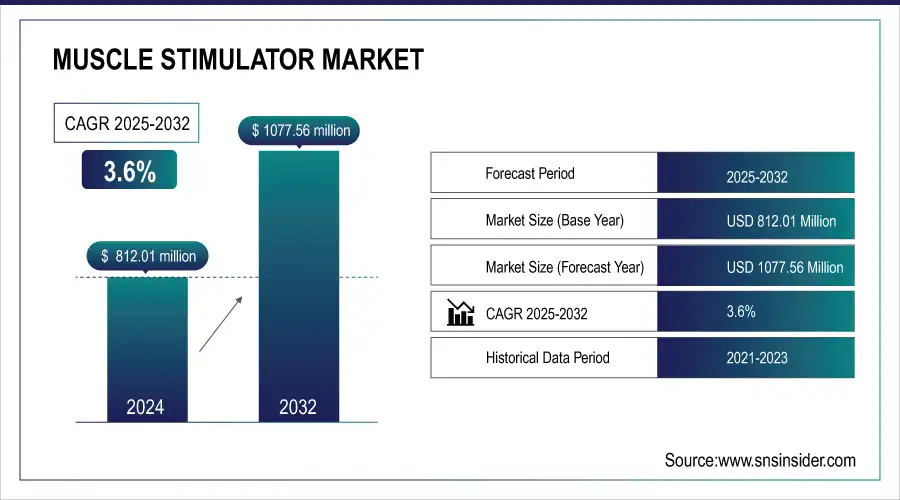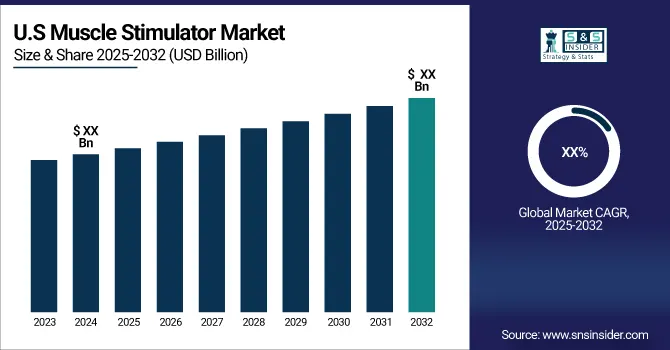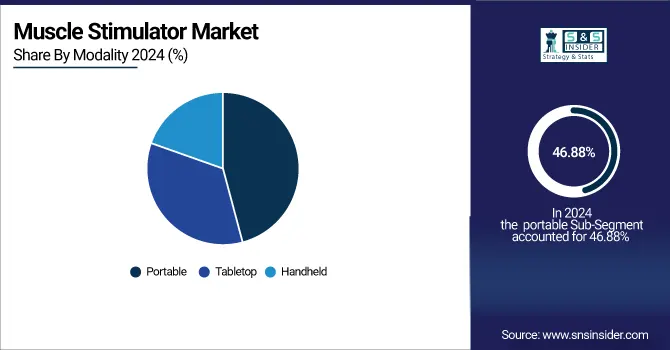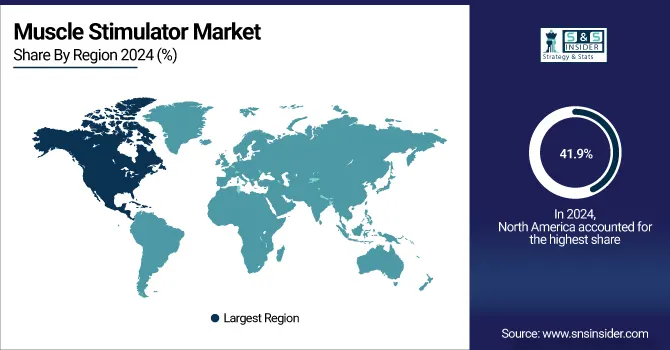Muscle Stimulator Market Report Scope And Overview:
The Muscle Stimulator Market size was valued at USD 812.01 million in 2024 and is expected to reach USD 1077.56 million by 2032 and grow at a CAGR of 3.6% over the forecast period 2025-2032.

Get More Information on Muscle Stimulator Market - Request Sample Report
Muscle stimulators, devices that deliver electrical impulses to stimulate muscles, are used for various applications, including pain management, muscle rehabilitation, and athletic performance enhancement.
The demand for muscle stimulators is fueled by the growing prevalence of chronic pain conditions, such as arthritis, fibromyalgia, and back pain. Patients are increasingly seeking non-invasive and drug-free alternatives for pain management, making muscle stimulators an attractive option. Additionally, athletes and sports enthusiasts use muscle stimulators to improve performance, reduce recovery time, and recover injuries. According to a study by the CDC shows that between 2019 and 2021, 21.2% of U.S. adults, equivalent to 53.2 million people, reported having a diagnosed case of arthritis. Among adults aged 65 and older who self-reported a diagnosis of dementia, chronic obstructive pulmonary disease, stroke, heart disease, diabetes, or cancer, approximately half (52.2%–62.4%) also reported being diagnosed with arthritis. In 2022, approximately 1.71 billion people worldwide suffered from musculoskeletal conditions, making them the leading cause of disabilities globally. Low back pain was identified as the leading cause of disability in 160 countries.
Government regulations, such as those enforced by the Food and Drug Administration (FDA), govern the sale and use of electrical muscle stimulators. The FDA ensures that these devices meet safety and efficacy standards for their intended purposes. Most EMS devices used in physical therapy and rehabilitation require a prescription from a healthcare professional. Companies selling EMS devices directly to consumers must demonstrate their safety and effectiveness for home use. The FDA is concerned about the unregulated marketing of EMS devices, as they may not comply with electrical safety standards, posing a risk of electrocution. The agency is investigating firms that are illegally selling these devices.
The muscle stimulator industry is witnessing an increase in mergers and acquisitions as companies seek to innovate and offer advanced solutions through research and development. Caldera Medical's acquisition of Atlantic Therapeutics in September 2023 is a prime example, expanding Caldera's product offerings to include non-invasive pelvic floor strengthening and nerve stimulation solutions for women. This acquisition positions Caldera Medical as a leading provider of comprehensive women's health solutions.
Market Size and Forecast:
-
Market Size in 2024 USD 812.01 Million
-
Market Size by 2032 USD 1077.56 Million
-
CAGR of 3.6% From 2025 to 2032
-
Base Year 2024
-
Forecast Period 2025-2032
-
Historical Data 2021-2023

Muscle Stimulator Market Trends:
-
Increasing cases of chronic conditions such as arthritis and fibromyalgia are boosting the demand for non-invasive muscle stimulation therapies.
-
Rising consumer awareness is driving acceptance of muscle stimulators for rehabilitation, wellness, and alternative therapy purposes.
-
Sedentary work styles, poor posture, and unhealthy habits are contributing to musculoskeletal issues requiring muscle stimulation solutions.
-
Growing number of sports-related injuries is fueling adoption of stimulators for recovery and performance optimization.
-
Expanding use of muscle stimulation devices in home care settings is supporting their popularity beyond clinical environments.
Muscle Stimulator Market Growth Drivers:
The muscle stimulator market is driven by the increasing prevalence of chronic pain, rising awareness of non-invasive therapies, and lifestyle-related musculoskeletal disorders. Growing sports injuries further fuel demand, as stimulators aid in recovery and performance enhancement. With consumers seeking effective rehabilitation and pain management solutions, adoption continues to expand across clinical, athletic, and home care settings.
Muscle Stimulator Market Restraints:
The muscle stimulator market faces restraints such as high device costs limiting accessibility, particularly in developing regions. Lack of awareness among consumers and healthcare providers hampers adoption despite proven benefits. Additionally, technical challenges, including device calibration issues and inconsistent therapeutic outcomes, reduce user confidence and restrict broader penetration of these solutions in the global market.
Muscle Stimulator Market Segment Analysis:
By Product Type
The transcutaneous electrical nerve stimulation (TENS) segment, held a dominant market share of 67.4% in 2024. This growth is attributed to the rising prevalence of arthritis and sports injuries. Among TENS, the burst mode alternating current (BMAC) segment is the fastest-growing, offering more efficient muscle stimulation and better clinical outcomes compared to traditional methods.
By Modality
The portable devices segment emerged as the dominant market leader in 2024, capturing the largest revenue share at 46.88%. This growth is fueled by the increasing popularity of portable muscle stimulators for a variety of applications, including preventing muscle atrophy, relaxing muscle spasms, managing chronic pain due to arthritis, and improving blood circulation.
Furthermore, the market is witnessing significant innovation from key players, who are introducing innovative portable stimulators. For instance, NeuroMetrix, Inc. offers a portable pain relief kit that fits like a brace and provides stimulation for pain relief. Zynex, Inc. has launched JetStream, a portable system that can be used at home for treatment. OMRON Corporation is also offering a small-sized portable electrotherapy TENS device for muscle pain relief. These factors are anticipated to drive the global market growth over the forecast period.

By Application
The pain management segment emerged as the dominant market leader in 2024, capturing the largest revenue share at 37.43%. This growth is fueled by the increasing prevalence of chronic pain, particularly among the aging population. According to the CDC, a significant portion of adults in the U.S. suffer from chronic pain, highlighting the need for effective and safe pain management solutions.
Muscle stimulators offer a promising alternative for managing pain, providing targeted relief without the potential side effects of medication. The growing usage of these devices for both acute and chronic pain, combined with the rising prevalence of arthritis, is anticipated to drive market growth within the pain management segment over the forecast period.
By End-use
The physiotherapy clinics segment emerged as the dominant market leader in 2024, capturing the largest revenue share at 34.03%. This growth is fueled by the increasing preference of physiotherapists for stimulators over manual techniques and the rising number of patients seeking stimulation therapies at affordable costs. Additionally, the availability of medical reimbursement for these therapies further bolsters segment growth.
The sports clinics segment is not far behind, occupying the second-largest revenue share in 2024. The growth of this segment is driven by the growing number of athletes seeking to enhance their performance and recover from injuries more effectively. Furthermore, the recognition of EMS therapy's value by professional sports organizations and governing bodies is contributing to its market expansion. For example, the National Athletic Trainers’ Association has included electrical modality treatments like muscle stimulation in its evidence-based practice guidelines for managing athletic injuries.
Muscle Stimulator Market Regional Analysis:
North America Muscle Stimulator Market Insights
The muscle stimulator market is dominated by North America, accounting for 41.9% of the global revenue share in 2024. This dominance is attributed to factors such as the presence of key market players, government investments in medical device innovation, and the early introduction of novel stimulators. Additionally, the high purchasing power of consumers and increasing adoption of advanced technologies are driving market growth in the region. Within North America, the U.S. market is particularly significant, driven by the growing number of product approvals. For instance, electronic muscle stimulators recently received FDA approval for strengthening core muscles, expanding their applications in physical therapy and rehabilitation.

Need any customization research on Muscle Stimulator Market - Enquiry Now
Europe Muscle Stimulator Market Insights
Europe, especially Germany, and the UK, is also experiencing market growth due to the increasing prevalence of musculoskeletal disorders. These countries are witnessing a rise in the use of muscle stimulators for treating conditions like muscle atrophy, spasms, and pain. In the UK, work-related musculoskeletal disorders have resulted in significant lost working days, driving demand for pain management solutions.
Asia Pacific Muscle Stimulator Market Insights
The Asia Pacific region, led by China and Japan, is projected to experience the fastest growth in the muscle stimulator market. Factors such as expanding healthcare infrastructure, growing healthcare workforce, and increasing awareness about health and fitness are driving market expansion in this region. Additionally, the growing prevalence of sports injuries is expected to stimulate demand for muscle stimulators.
Latin America (LATAM) and Middle East & Africa (MEA) Muscle Stimulator Market Insights
The Latin America and Middle East & Africa muscle stimulator markets are growing steadily, supported by rising cases of chronic pain, sports injuries, and rehabilitation needs. However, high costs and limited awareness restrain adoption. Expanding healthcare infrastructure, increasing interest in physiotherapy, and gradual acceptance of non-invasive pain management solutions are creating opportunities for wider use across these regions.
Muscle Stimulator Market Key Players:
-
EMS Physio Ltd.
-
Beurer GmbH.
-
BioMedical Life Systems, Inc.
-
Zimmer MedizinSysteme GmbH
-
OG Wellness Technologies Co., Ltd.
-
DJO Global, Inc
-
STYMCO Technologies, Inc.
-
Tone-A-Matic, Inc.
-
EMSI (Electro-Medical Supply Inc.)
-
Cyberonics, Inc.
-
BioMedical Research Ltd. (BMR)
-
Guangzhou Gloryang Medical Technology Co., Ltd.
-
ITO Co., Ltd.
-
Performance Health (TheraBand)
-
Chattanooga Group (part of DJO Global)
-
GZ Longest Science & Technology Co., Ltd.
Competitive Landscape for Muscle Stimulator Market:
NeuroMetrix, Inc. is a U.S.-based medical device company specializing in neurostimulation and digital therapeutics for chronic pain management. In the muscle stimulator market, its innovative wearable devices provide non-invasive, drug-free solutions for conditions like neuropathy, back pain, and fibromyalgia. The company emphasizes technology-driven pain relief, improving patient outcomes, and expanding access to advanced rehabilitation and wellness therapies.
-
NeuroMetrix, Inc. (2024) Launched a new line of portable muscle stimulators with advanced features and customizable settings. Expanded its global distribution network to reach a wider customer base.
Zynex, Inc. is a leading U.S.-based medical technology company focused on developing non-invasive electrotherapy devices for pain management and rehabilitation. In the muscle stimulator market, its FDA-cleared products help treat chronic pain, manage post-operative recovery, and support muscle re-education. The company’s solutions emphasize drug-free alternatives, improving patient comfort, functionality, and quality of life worldwide.
-
Zynex, Inc. (2024) Introduced a wireless muscle stimulator with a long-lasting battery and intuitive app control. Partnered with several physical therapy clinics to promote the use of their products.
| Report Attributes | Details |
|---|---|
| Market Size in 2024 | USD 812.01 Million |
| Market Size by 2032 | USD 1077.56 Million |
| CAGR | CAGR of 3.6% From 2025 to 2032 |
| Base Year | 2024 |
| Forecast Period | 2025-2032 |
| Historical Data | 2021-2023 |
| Report Scope & Coverage | Market Size, Segments Analysis, Competitive Landscape, Regional Analysis, DROC & SWOT Analysis, Forecast Outlook |
| Key Segments | • By Product Type (Neuromuscular electrical stimulation, Functional electrical stimulation, Transcutaneous electrical nerve stimulation, Interferential, Burst mode alternating current, Micro Current EMS, Others) • By Modality (Handheld, Portable, Tabletop) • By Application (Pain Management, Neurological disorder, Musculoskeletal disorder, Others) • By End-use (Hospitals, Ambulatory surgical centers, Physiotherapy clinics, Sports clinics, Home Care) |
| Regional Analysis/Coverage | North America (US, Canada), Europe (Germany, UK, France, Italy, Spain, Russia, Poland, Rest of Europe), Asia Pacific (China, India, Japan, South Korea, Australia, ASEAN Countries, Rest of Asia Pacific), Middle East & Africa (UAE, Saudi Arabia, Qatar, South Africa, Rest of Middle East & Africa), Latin America (Brazil, Argentina, Mexico, Colombia, Rest of Latin America). |
| Company Profiles | RS Medical, Inc., NeuroMetrix, Inc., EMS Physio Ltd., OMRON Corporation, Beurer GmbH., BioMedical Life Systems, Inc., Zimmer MedizinSysteme GmbH, Zynex, Inc., OG Wellness Technologies Co., Ltd., DJO Global, Inc. |

